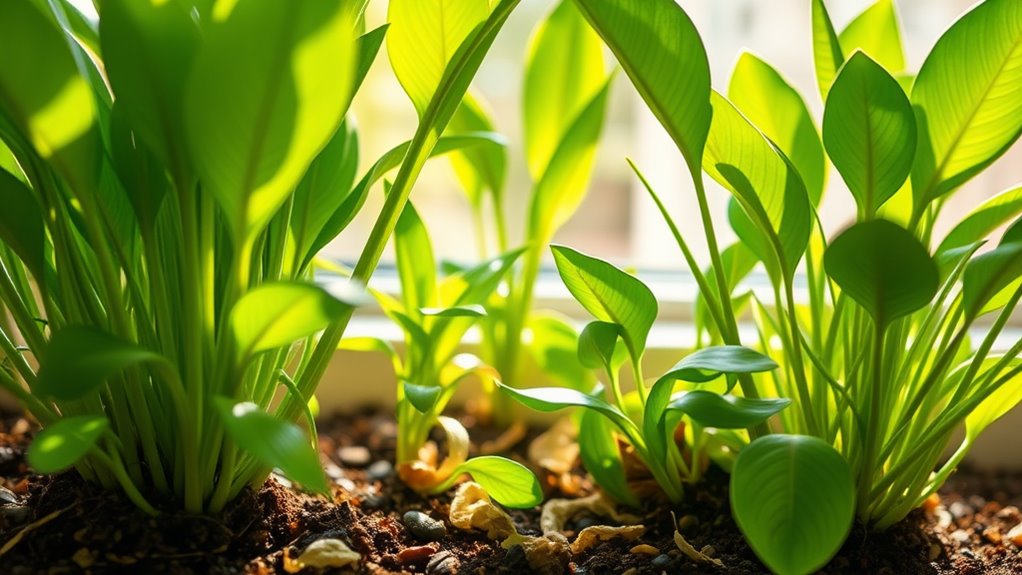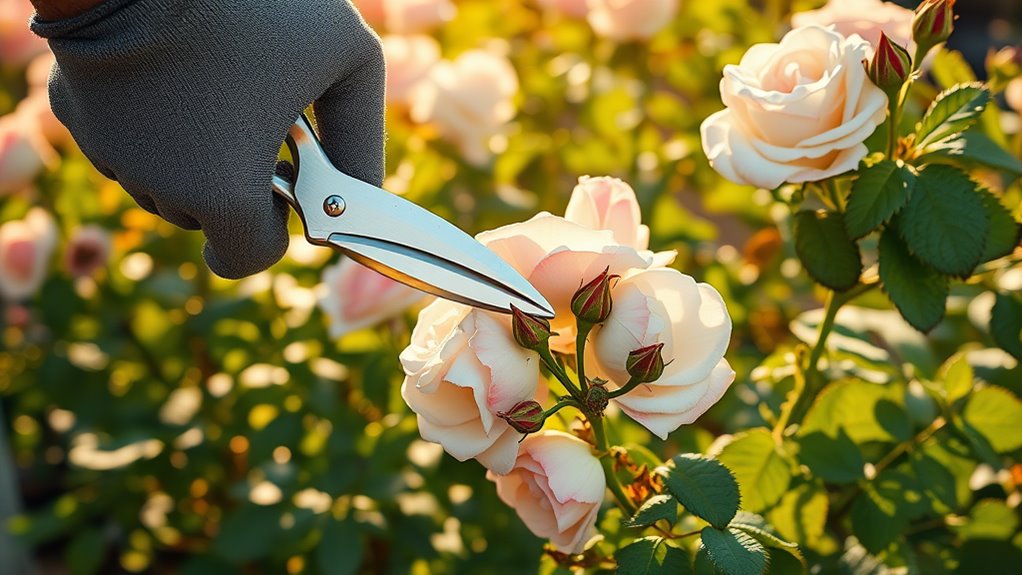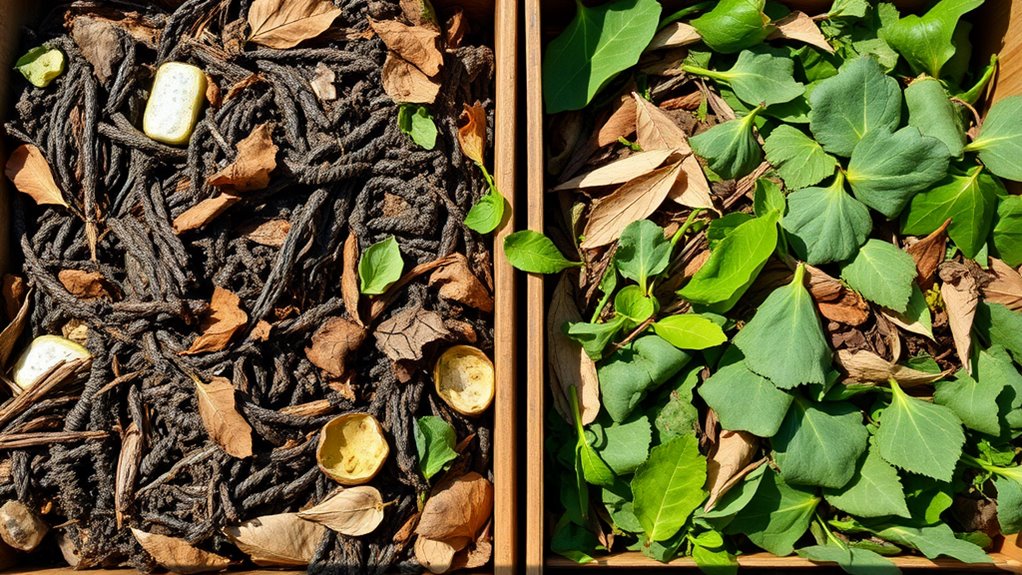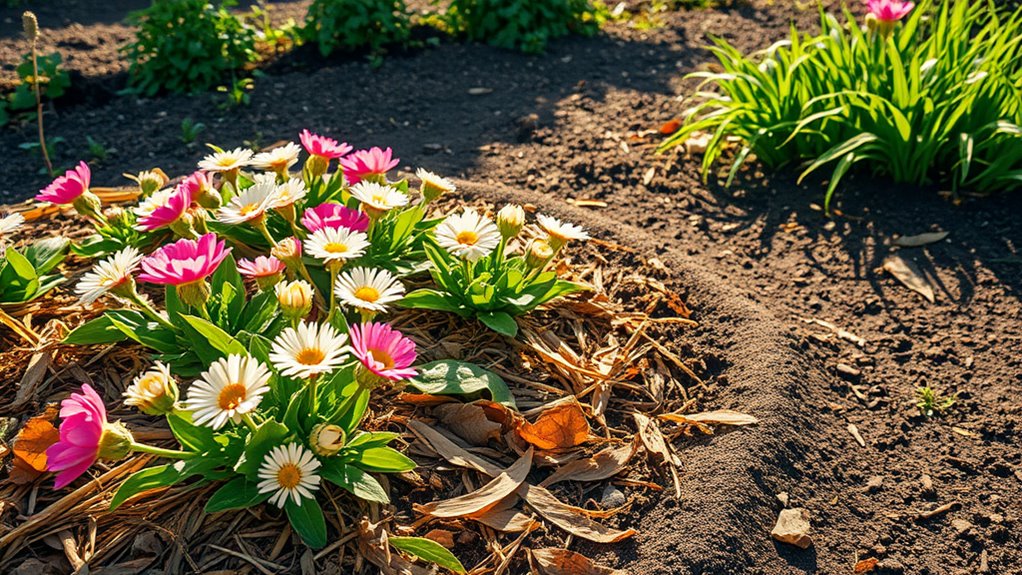The Secret to Healthy Plants Might Be in Your Trash Can
You might not realize it, but your kitchen scraps hold the secret to thriving plants—turn peels, coffee grounds, and eggshells into nutrient-rich compost that delivers nitrogen for photosynthesis and phosphorus for strong roots. Build a simple bin in a shady spot, layer with leaves for balance, and aerate weekly to maintain ideal moisture and temperature. By tackling these basics, you’ll foster resilient gardens, with even more innovative uses waiting just ahead.
Key Takeaways
- Turn kitchen scraps like fruit peels and coffee grounds into compost for nutrient-rich soil that boosts plant health.
- Compost provides essential nutrients such as nitrogen, phosphorus, and potassium to support strong plant growth.
- Layer kitchen waste with brown materials like leaves and aerate regularly to ensure efficient decomposition.
- Use compost to improve soil texture, retain moisture, and enhance microbial activity for resilient plants.
- Apply compost as a top dressing or in potting mixes to suppress weeds and promote better germination and flowering.
Kitchen Scraps That Make Great Compost
If you’re tossing out kitchen scraps, you can turn many of them into nutrient-rich compost that nourishes your plants. By following a simple composting technique, you can enhance your home garden’s health and sustainability. Effective compost ingredients include fruit and vegetable peels, coffee grounds, and eggshells, which supply essential nutrients like nitrogen, potassium, and calcium.
You balance these with carbon-rich items such as tea bags and shredded paper to create a thriving microbial environment. Scientifically, these materials decompose through bacterial action, releasing minerals that enhance soil structure and plant health.
Avoid meat or dairy, as they attract pests and disrupt the process, ensuring your compost remains practical and efficient.
This practice transforms your kitchen waste into garden gold, fostering healthier plants and a more sustainable garden.
Building Your Own Compost System at Home
Now that you’ve collected those nutrient-rich kitchen scraps, you’ll want to set up a simple compost system to turn them into fertile soil. Choose a shady, well-drained spot for your bin or pile. Layer green materials (like scraps) with browns (like leaves) for optimal decomposition. Aerate weekly and keep it moist but not soggy. Monitor temperature to ensure it reaches 130-150°F for efficient breakdown. This process not only recycles waste but also helps enhance soil health through proper decomposition techniques. For those with limited areas, implementing small spaces composting can make the process even more manageable.
| Compost Element | Key Tip |
|---|---|
| Bin Selection | Use a ventilated container for better airflow. |
| Material Ratio | Aim for 2:1 browns to greens by volume. |
| Moisture Level | Maintain like a wrung-out sponge. |
| Turning Frequency | Stir every 7-10 days. |
| Size Consideration | Start with 3x3x3 feet for effective heating. |
Nutrient Benefits of Compost for Plants
Compost enriches your soil with essential nutrients like nitrogen, phosphorus, and potassium, directly fueling plant growth and vitality. By incorporating compost, you’re enhancing soil fertility, improving microbial activity, and boosting overall plant resilience without synthetic additives. Additionally, implementing simple ingredient swaps can further enrich your compost for more efficient decomposition and richer soil outcomes.
-
Nitrogen drives photosynthesis and leafy growth, keeping your plants vibrant.
-
Phosphorus supports root development and flower production, ensuring stronger blooms.
-
Potassium regulates water uptake and disease resistance, helping your garden thrive.
-
Organic matter improves soil texture, retaining moisture and nutrients for sustained health.
Embracing low-effort composting makes it easy for busy beginners to create this nutrient-rich compost at home.
Common Challenges in Composting and Fixes
Though compost enriches your soil with vital nutrients, you may encounter obstacles like slow decomposition or foul odors during the process. By applying practical troubleshooting solutions, gardeners can quickly revive their composting process and achieve rich, healthy soil.
Slow decomposition often stems from poor aeration or imbalanced materials; balance your greens and browns, and turn the pile weekly to boost oxygen flow and microbial activity.
Foul odors signal excess moisture or anaerobic conditions; add dry carbon-rich materials and drain excess water to restore equilibrium.
Pests arise from exposed food scraps; cover them promptly and maintain a hot pile through regular monitoring.
These fixes ensure efficient, odor-free composting for healthier gardens.
By reflecting on lessons learned from composting mistakes, gardeners can prevent potential garden disasters.
Creative Ways to Use Compost in Gardening
Once you’ve prepared nutrient-rich compost, you can enhance your garden’s vitality by applying it in innovative ways, such as mixing it into seed-starting mixes for better germination or using it as a top dressing to suppress weeds and retain soil moisture.
This method improves soil structure and microbial activity, fostering sustainable growth. Additionally, this technique aligns with sustainable practices that help reduce environmental impact through natural resource recycling.
-
Boost seedlings: Blend compost into your potting mix to enhance nutrient availability and root development.
-
Create tea: Steep compost in water for a liquid fertilizer that promotes foliar absorption and disease resistance.
-
Mulch effectively: Spread it around plants to reduce evaporation and inhibit weed growth naturally.
-
Enrich beds: Incorporate compost into soil to increase organic matter and support beneficial earthworms.
By following the simple steps in an easy composting routine, you can create that nutrient-rich “black gold” soil for your garden.





